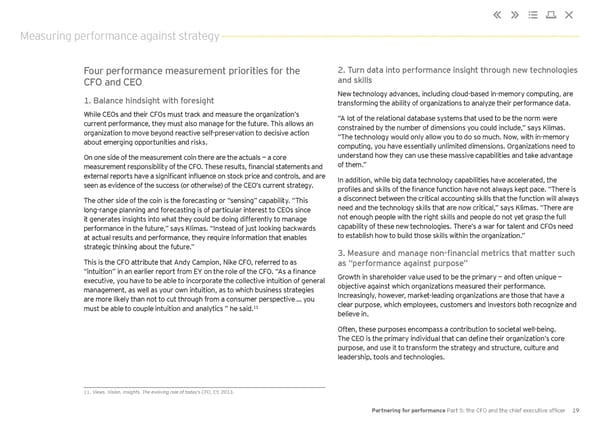Measuring performance against strategy Four performance measurement priorities for the 2. Turn data into performance insight through new technologies CFO and CEO and skills 1. Balance hindsight with foresight New technology advances, including cloud-based in-memory computing, are transforming the ability of organizations to analyze their performance data. While CEOs and their CFOs must track and measure the organization’s “A lot of the relational database systems that used to be the norm were current performance, they must also manage for the future. This allows an constrained by the number of dimensions you could include,” says Klimas. organization to move beyond reactive self-preservation to decisive action “The technology would only allow you to do so much. Now, with in-memory about emerging opportunities and risks. computing, you have essentially unlimited dimensions. Organizations need to On one side of the measurement coin there are the actuals — a core understand how they can use these massive capabilities and take advantage measurement responsibility of the CFO. These results, financial statements and of them.” external reports have a significant influence on stock price and controls, and are In addition, while big data technology capabilities have accelerated, the seen as evidence of the success (or otherwise) of the CEO’s current strategy. profiles and skills of the finance function have not always kept pace. “There is The other side of the coin is the forecasting or “sensing” capability. “This a disconnect between the critical accounting skills that the function will always long-range planning and forecasting is of particular interest to CEOs since need and the technology skills that are now critical,” says Klimas. “There are it generates insights into what they could be doing differently to manage not enough people with the right skills and people do not yet grasp the full performance in the future,” says Klimas. “Instead of just looking backwards capability of these new technologies. There’s a war for talent and CFOs need at actual results and performance, they require information that enables to establish how to build those skills within the organization.” strategic thinking about the future.” 3. Measure and manage non-financial metrics that matter such This is the CFO attribute that Andy Campion, Nike CFO, referred to as as “performance against purpose” “intuition” in an earlier report from EY on the role of the CFO. “As a finance Growth in shareholder value used to be the primary — and often unique — executive, you have to be able to incorporate the collective intuition of general objective against which organizations measured their performance. management, as well as your own intuition, as to which business strategies Increasingly, however, market-leading organizations are those that have a are more likely than not to cut through from a consumer perspective … you clear purpose, which employees, customers and investors both recognize and 11 must be able to couple intuition and analytics ” he said. believe in. Often, these purposes encompass a contribution to societal well-being. The CEO is the primary individual that can define their organization’s core purpose, and use it to transform the strategy and structure, culture and leadership, tools and technologies. 11. Views. Vision. Insights. The evolving role of today’s CFO, EY, 2013. Partnering for performance Part 5: the CFO and the chief executive officer 19
 Partnering for Performance Part 5 Page 20 Page 22
Partnering for Performance Part 5 Page 20 Page 22